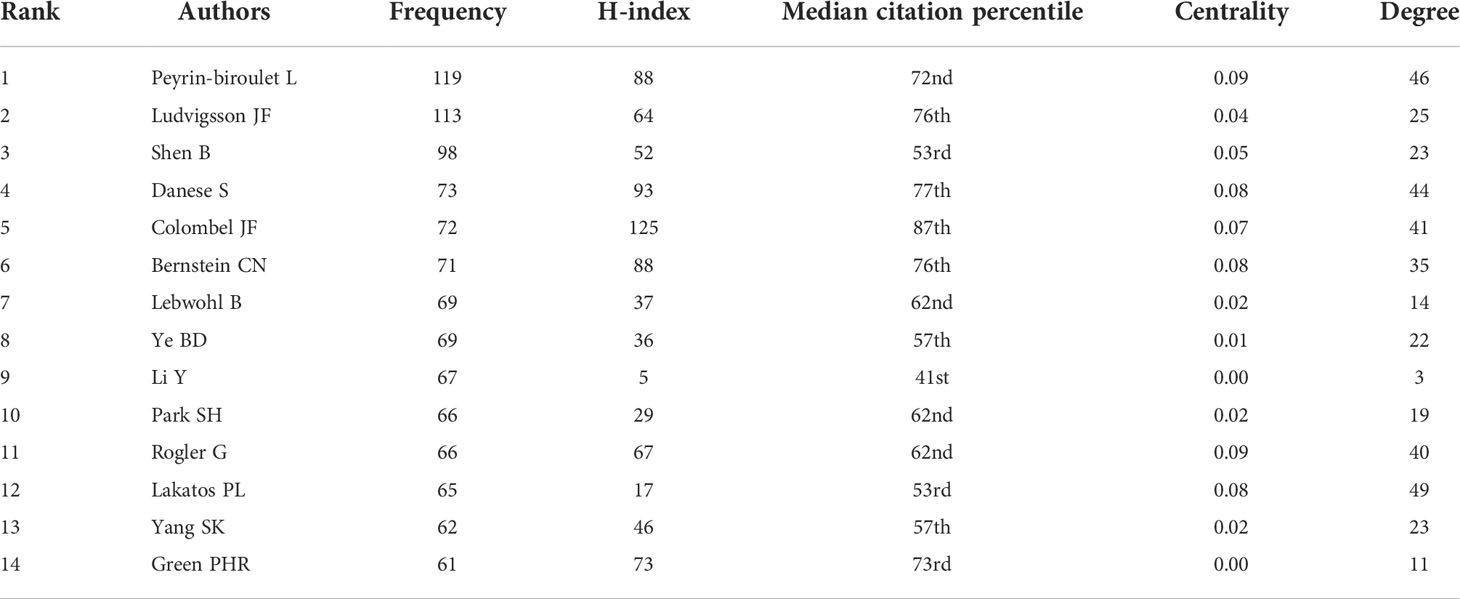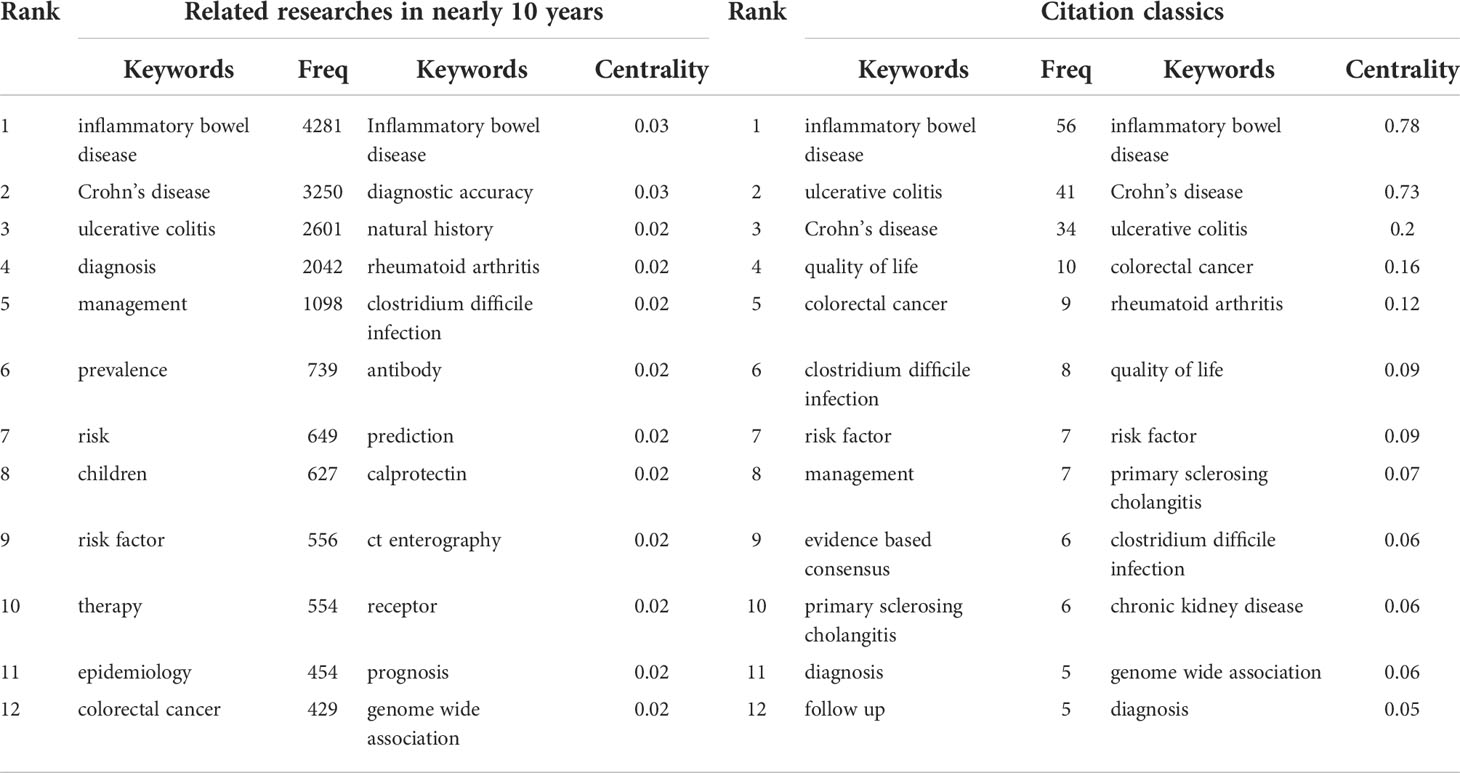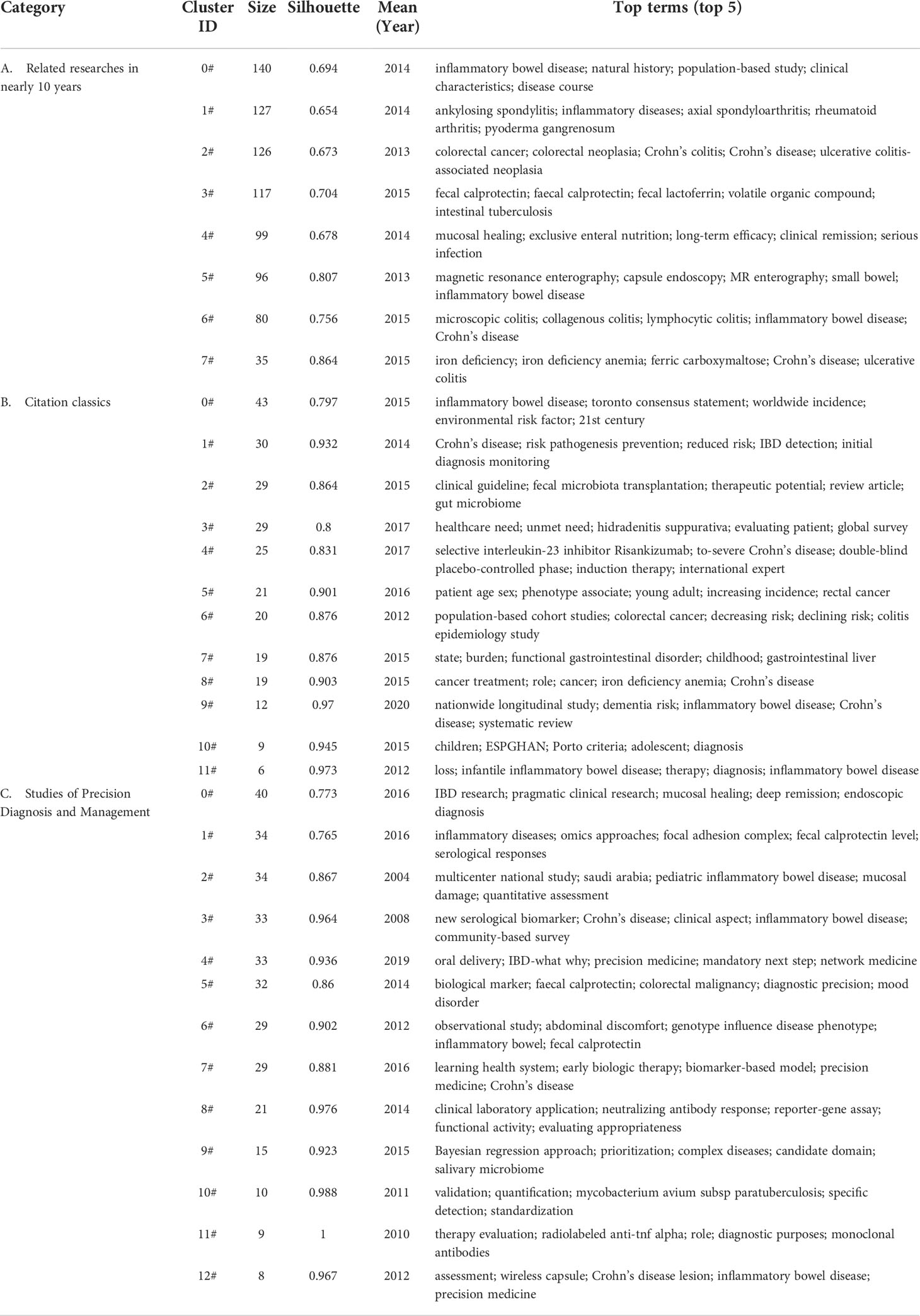- 1Department of Gastroenterology, Renmin Hospital of Wuhan University, Wuhan, China
- 2Department of Gastroenterology, Children’s Hospital Affiliated to Zhengzhou University, Zhengzhou, China
- 3Department of General Surgery, The 940th Hospital of Joint Logistic Support Force of Chinese People’s Liberation Army, Lanzhou, China
Aims: This study aimed to conduct a bibliometric analysis of the relevant literature on the diagnosis of inflammatory bowel disease (IBD), and show its current status, hot spots, and development trends.
Methods: The literature on IBD diagnosis was acquired from the Science Citation Index Expanded of the Web of Science Core Collection. Co-occurrence and cooperation relationship analysis of authors, institutions, countries, journals, references, and keywords in the literature were carried out through CiteSpace software and the Online Analysis platform of Literature Metrology. At the same time, the relevant knowledge maps were drawn, and the keywords cluster analysis and emergence analysis were performed.
Results: 14,742 related articles were included, showing that the number of articles in this field has increased in recent years. The results showed that PEYRIN-BIROULET L from the University Hospital of Nancy-Brabois was the author with the most cumulative number of articles. The institution with the most articles was Mayo Clin, and the United States was far ahead in the article output and had a dominant role. Keywords analysis showed that there was a total of 818 keywords, which were mainly focused on the research of related diseases caused or coexisted by IBD, such as colorectal cancer and autoimmune diseases, and the diagnosis and treatment methods of IBD. Emerging analysis showed that future research hotspots and trends might be the treatment of IBD and precision medicine.
Conclusion: This research was the first bibliometric analysis of publications in the field of IBD diagnosis using visualization software and data information mining, and obtained the current status, hotspots, and development of this field. The future research hotspot might be the precision medicine of IBD, and the mechanism needed to be explored in depth to provide a theoretical basis for its clinical application.
1 Introduction
Inflammatory bowel disease (IBD) is a gastrointestinal illness that is systemic, autoimmune, recurrent, and remission, with a peak onset between the ages of 20 and 30 years (1, 2). With a frequency of more than 0.3 percent in Western populations, IBD has become a global problem (3). Ulcerative colitis (UC) and Crohn’s disease (CD) are the two main forms of IBD (4, 5), which can be distinguished by different pathological features (6). IBD patients usually have bowel symptoms, but symptoms and signs of systemic inflammation may also occur, including extraintestinal manifestations (7). Sometimes these signs and symptoms are so mild that IBD is not clinically suspected, but they may be discovered accidentally during colonoscopy for other reasons (8). IBD is currently incurable, and its treatment focuses on inducing and maintaining remission, reducing hospitalization and surgery (9).
Therefore, it is significant to diagnose IBD in a timely and correct manner. Many consensuses and guidelines have put forward clearer diagnostic criteria for IBD, but also clearly stated that the diagnosis of IBD requires careful differential diagnosis (10, 11). In recent years, with the in-depth research on the pathogenesis of IBD and the advancement of auxiliary examination techniques, there have been many new understandings of the diagnosis and differential diagnosis of IBD, which allows us to have a more comprehensive understanding of IBD and make a more accurate diagnosis. So, analyzing the clinical application progress, research status, hotspots, and development trends of IBD diagnostic research has important reference value for the extended application of IBD diagnosis in clinical practice and deeper basic research. In addition, with the deepening of research related to IBD diagnosis, the amount of literature information has grown rapidly. As a result, manual retrieval of documents has been difficult to show the full picture and progress of the research field.
Bibliometrics was defined by Pritchard in 1969 as a mathematics and statistical method to analyze literature, books and other communities. This technique, as a useful and effective tool for literature analysis, has been widely applied in different scientific knowledge domains (12). So bibliometrics is a cross-discipline that uses mathematical and statistical methods to quantitatively analyze knowledge carriers. The scientific knowledge map is a visual presentation of scientific knowledge, which can explore, draw, analyze, summarize and reveal knowledge structure and fields from the time and space dimensions (13). In recent years, the combination of knowledge visualization and bibliometrics can reveal information such as the research model, structural relationship and development process of knowledge intuitively and vividly (14, 15). Although there are many kinds of visualization analysis software such as Sci2, CiteSpace, VOS viewer, etc., CiteSpace is currently one of the most popular knowledge graph drawing tools, which is an information visualization tool developed by Professor Chen CM using Java language (16). CiteSpace has the characteristics of supporting multiple data formats, comprehensive functions and good visualization effects, and has been applied to related research in many disciplines (17).
Bibliometric has been widely used in various areas of medicine as a burgeoning method, such as internal medicine, surgery and other clinical fields (18–20). And the number of relevant bibliometrics has increased exponentially in recent years. In addition, there have been a large number of bibliometric studies on IBD. Connelly TM et al. conducted a metrological visualization analysis on 100 classic papers on UC (21). Schöffel N et al. summarized the global research output and network of UC through scientometric approach (22). Azer SA et al. conducted a bibliometric analysis of the 50 most cited IBD articles (23). However, there is no visual quantitative analysis for IBD diagnostic research. The literature in recent ten years is more referential for grasping the current research situation and guiding the research on the future trend. Therefore, based on the bibliometric method and scientific knowledge map, this study used CiteSpace software to visually analyze the international research progress and current status of IBD diagnosis in the past ten years from multiple perspectives such as document distribution and co-occurrence maps. At the same time, it revealed the research hotspots and future trends of relevant publications through the timeline view and the track of mutation words, and made some prospects for the research frontiers. In addition, we screened the scientific literature on precise diagnosis and management of IBD to provide reference and data support for international IBD diagnosis research.
2 Materials and methods
2.1 Data source
This study was a bibliometric study that did not involve any clinical trials and patient consent. Therefore, there was no need for the approval of the ethics committee or institutional review board. Data were acquired from the Science Citation Index Expanded (SCI-E) of the Web of Science Core Collection (WoSCC) of Clarivate Analytics (https://clarivate.com/) on April 28, 2022. The search time range was from January 1, 2012, to December 31, 2021, and the search was limited to publications written in the English language. In the WoSCC database, the subject term search method was used, and the subject area was not limited. The search strategy was (“inflammatory bowel disease” or “Crohn” or “Crohns-disease” or “ulcerative colitis” or “IBD” or “CD” or “UC”) and “diagnosis”. All electronic searches were performed on April 28, 2022. Two independent reviewers collected all the data by reading the titles and abstracts acquired from SCI-E of the WoSCC database. When necessary, the full texts were downloaded from PubMed or other databases. Any differences between the two reviewers were settled through discussion with a third reviewer.
2.2 Data establishment and processing
2.2.1 Data creation and conversion
Note Express, a full-featured document management software program, was used to manage the studies obtained from different databases, with document information retrieval, download, and classification functions. The retrieved journal articles researching the diagnosis of IBD were imported into Note Express software and duplicated literature was electronically removed, further screening, and finally, 14,742 articles were included. Document data exported from WoSCC were saved in “RefWorks” format. Two researchers reviewed the selected articles, and the following data were identified and recorded for analysis: (1) titles, (2) authors, (3) citation number, (4) keywords, (5) publication year, (6) topics (7) reference and (8) institutions and countries of origin. Furthermore, the journal names and impact factors (IFs) were also recorded using the 2021 edition of the Journal Citation Reports (JCR). Data were converted to “txt” format, named download_*.txt, and then imported into CiteSpace 5.8.R3 version and the Online Analysis platform of Literature Metrology (OALM) (http://bibliometric.com/) for analysis. OALM provides researchers with bibliometric analysis of scientific citation data in the form of graphic visualization through web services, and provides valuable reference information for researchers to carry out research with the simplest operation method and the most intuitive expression method.
2.2.2 Data processing
Excel software was used to analyze the included literature data. We selected appropriate parameters in the CiteSpace 5.8.R3 version to generate co-occurrence visualization maps of journals, authors, institutions, countries, references, and keywords for IBD diagnostic research, and performed cluster analysis and emergence analysis of keywords. ①Time slicing: 2012-2021; time zone selection (year per slice): 1 year; node type: author, institution, country, reference, cited author, cited journal, keyword. ②The threshold (top N per slice): 10%, that is, the top 10% but less than 100 high-frequency keywords were selected in each time zone. In order to prevent the co-citation network from being too complex, a Pathfinder algorithm was used in this paper, which could simplify the network by removing the edges that violate the triangle inequality and accurately extract the key structure of the network. The default system was selected for visualization. CiteSpace standardized algorithms included the Cosine similarity algorithm, Jaccard similarity algorithm, and Dice similarity coefficient. The next step was to analyze the relationship between the data. The software used the method of cluster analysis to reveal the correlation. CiteSpace clustering algorithm mainly used nominal terms to detect research hotspots, which could help researchers find mutation words in the map, explore research hotspots, and grasp the research direction. There were three Clustering algorithms: Clustering algorithm, LLR algorithm, and MI algorithm. At the same time, OALM was used to analyze the number of common national articles by year, the number of common keywords by year, partnerships (including authors, institutions, and countries) and article citation relationships.
3 Results
3.1 The number of literature and general characteristics
Based on WoSCC, it was found that the overall trend of the number of published articles was increasing from 2012 to 2021, indicating that the research on the diagnosis of IBD had received attention and the value of mining was getting higher and higher (Figure 1A). At present, the number of articles published in 2021 had reached the maximum, with a total of 2,202 articles. According to Price’s law, the growth of literature production was exponential, and the exponential curve equation was y = 8E-79e0.0928x. The simulation curve fits well with the annual literature growth trend with a high coefficient of determination (R2 = 0.9818) (Figure 1B). By the fitting curve, we can predict that the annual articles will continue to grow in the coming years. According to the exponential curve equation, the average annual growth rate was 9.28%. According to the calculation of the mathematical formula, the literature doubling time was 7.47 years. In addition, we selected 134 highly cited and hot papers in this field in the past ten years, and referred to these as “citation classics” (Supplementary Table 1). Among them, the number of articles published in 2017 was the most, reaching 19 (Figure 1C). Most of the document types were articles (Figure 1F). In addition, based on OALM, the number of published articles in common countries had been counted year by year (Figures 1D, E).
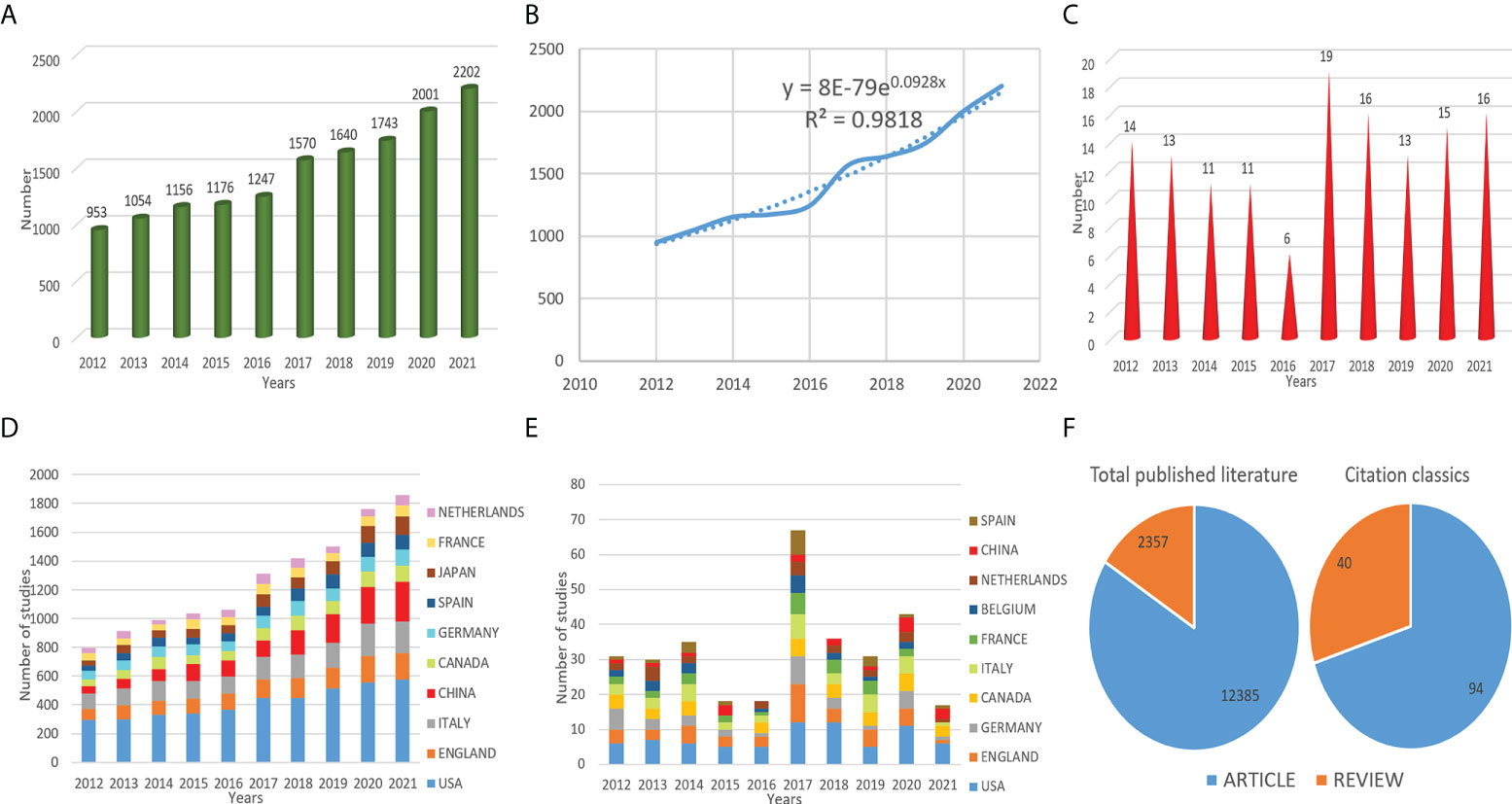
Figure 1 Annual number of publications (A), exponential growth graph of number of publications (B), the number of publications per year in common countries (D) of IBD diagnostic studies in the past ten years, and annual number of publications (C), the number of publications per year in common countries (E) of citation classics, and the type of literature (F).
3.2 Author analysis
Based on WoSCC, there were 62,916 authors involved in relevant research in the past ten years, and 1,605 authors were involved in citation classics (Figures 2A, B). The cooperative network of the authors and the cited authors was analyzed through CiteSpace, and the co-occurrence visualization maps were obtained. Based on CiteSpace, the analysis was as follows: There were 702 nodes in the research in the past ten years, representing 702 authors (Figure 2D), and there were 280 nodes in citation classics (Figure 2E). The larger the node was, the more articles the author published. Among them, the author with the highest cumulative number of articles was Peyrin-biroulet L, with 119 articles. Based on the Web of Science, the high citations index (h-index) is a mixed quantitative index, which can be used to evaluate the number and level of academic output of researchers. Also based on the Web of Science, the median citation percentile can reflect the influence of the author. The author of Colombel JF was the most influential, with an h-index of 125 and a median citation percentile of 87th (Table 1). In the past ten years of research, there were 1,034 cited authors (Figure 2F), and 382 of the citation classics (Figure 2G). There was a cooperative relationship between highly productive authors and a stable research team had been formed. At the same time, the author’s cooperation network diagram also showed that half of the research teams have little cooperation (Figure 2C).
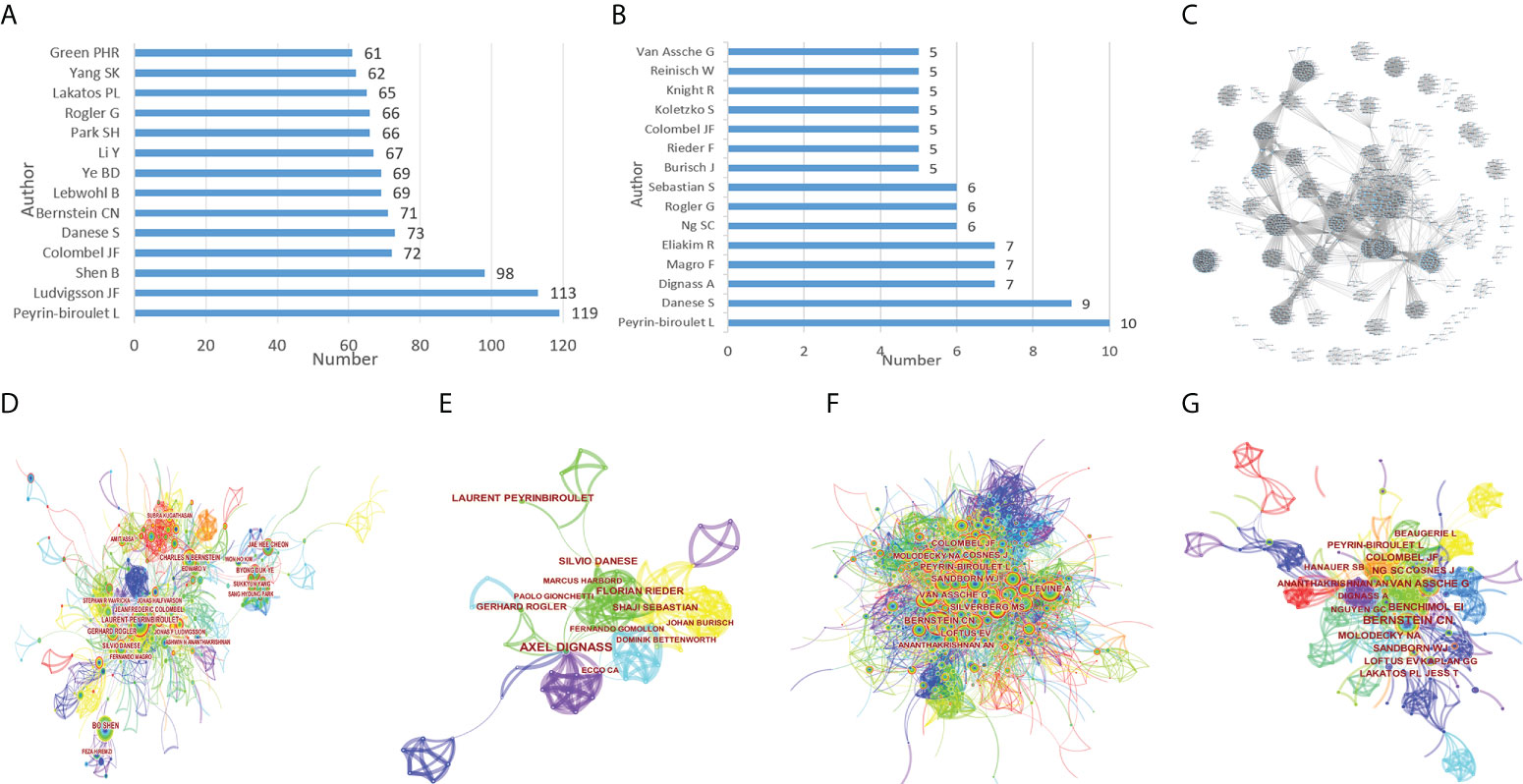
Figure 2 The number of articles published by common authors (A), the co-occurrence of authors (D), the co-occurrence of cited authors (F) of IBD diagnostic studies in the past ten years, and the number of articles published by common authors (B), the co-occurrence of authors (E), the co-occurrence of cited authors (G) and the cooperation relationship between authors (C) of citation classics.
3.3 Country and institution analysis
Based on WoSCC, there were 149 countries/regions and 11,324 institutions in the relevant research in the past ten years. Among them, the USA published the most articles, reaching 4178 articles (Figure 3A), and Harvard University had the most articles, reaching 488 articles (Figure 3C). At the same time, 65 countries and 826 institutions were involved in the citation classics. The USA published the most articles with 75 articles (Figure 3B), and Harvard University had the most articles with 18 articles (Figure 3D). The cooperative networks of the countries and the institutions were analyzed through CiteSpace, and the co-occurrence visualization maps were obtained. Based on CiteSpace, the analysis was as follows: In the past ten years, there were 180 countries/regions (Figure 3E). Among them, the USA had the most published articles with 4,020 articles, followed by ITALY, CHINA, ENGLAND, GERMANY, and CANADA, all with more than 500 articles. Among the citation classics, there were 65 countries, with the USA leading the list with 75 papers, and 7 countries had published more than 20 papers (Figure 3F). There were 563 institutions in the literature in the past ten years (Figure 3G). Among them, Mayo Clin had the most published articles with 358 articles, followed by Karolinska Inst, Univ Toronto, Tel Aviv Univ, Harvard Med Sch, Cleveland Clin, Massachusetts Gen Hosp, Univ Milan, Icahn Sch Med Mt Sinai, Univ Penn, and Univ Calgary, all with more than 100 articles. Among the citation classics, there were 263 institutions, of which Mayo Clin had published the most with 13 articles, and there were 9 institutions with articles number ≥ 5 (Figure 3H). Based on OALM, each small black dot represented an institution, and the connection represented mutual cooperation. It could be seen that the institutions were closely connected, and most of the research institutions were universities (Figures 3K, L). Countries had stable cooperative relations, but most countries had fewer connections (Figures 3I, J).

Figure 3 The number of articles published by common countries (A), the co-occurrence of countries (E), the cooperation relationship between countries (I) of IBD diagnostic studies in the past ten years, and the number of articles published by common countries (B), the co-occurrence of countries (F), the cooperation relationship between countries (J) of citation classics; the number of articles published by common institutions (C), the co-occurrence of institutions (G), the cooperation relationship between institutions (K) of IBD diagnostic studies in the past ten years, and the number of articles published by common institutions (D), the co-occurrence of institutions (H), the cooperation relationship between institutions (L) of citation classics.
3.4 Citation analysis of articles and journals
Based on WoSCC, related researches in the past ten years had been published in 2,771 journals. Inflammatory bowel diseases (2021 IF=7.29) contributed the most to this research field, reaching 590 articles (Figure 4A). Among the citation classics, 59 journals were involved, and Gastroenterology (2021 IF= 33.88) published the most articles, reaching 20 articles (Figure 4E). The cooperative networks of the cited journals and references were analyzed through CiteSpace, and the co-occurrence visualization maps were obtained. Based on CiteSpace, the analysis was as follows: In the past ten years, 1,462 journals were cited, of which Gastroenterology was cited the most, up to 6576 times, and 17 journals were cited more than 2000 times (Figure 4B). There were 313 journals cited in citation classics, of which Gastroenterology was the most cited, reaching 100 times, and there were 14 journals with ≥ 50 citations (Figure 4F). In the recent ten years of research, the article (24) had been cited the most, up to 268 times, and ≥100 times were 18 studies (Figure 4C). Among the citation classics, the article (24) also was cited the most, reaching 12 times, and ≥5 times were 8 studies (Figure 4G). In the article citation relationship network diagram based on OALM, each small black dot represented a study, and the lines represented mutual citations. It could be seen that the mutual references were relatively close, especially in the studies in the past ten years (Figures 4D, H).
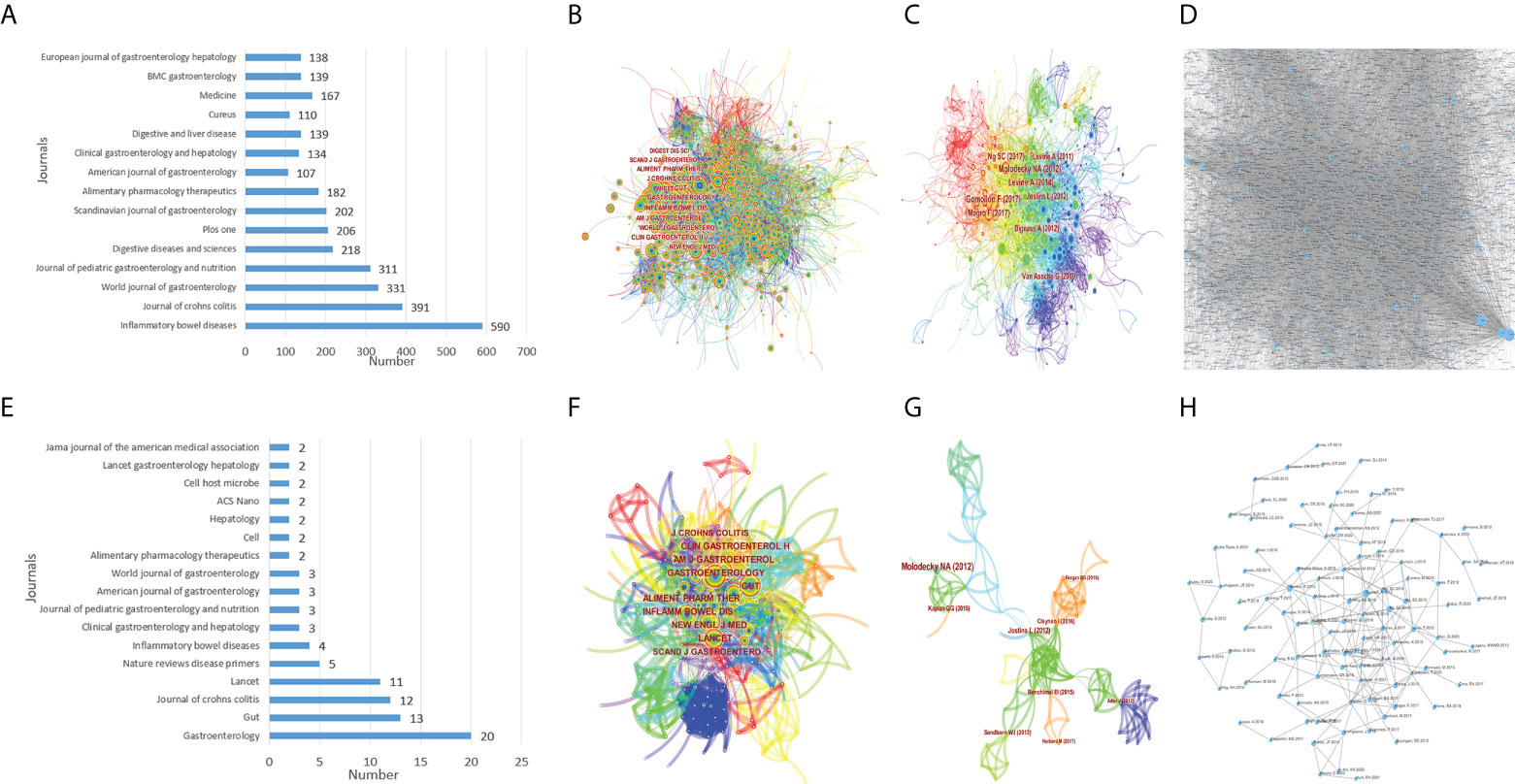
Figure 4 The number of aricles publishe by journals (A), the co-occurrence of journals (B), the co-occurrence of cited journals (C), the co-occurrence relationship between journals (D) of IBD diagnostic studies in the past ten years, and the number of articles published by journals (E), the co-occurrence of journals (F), the co-occurrence of cited journals (G), the cooperation relationship between journals (H) of citation classics.
3.5 Keywords analysis
3.5.1 Word frequency analysis
Keywords play the role of condensing and generalizing the theme of the literature. Counting the keywords in the research literature and obtaining keywords with more citations, reflects the importance of the keywords to a certain extent, and can be used to analyze the evolution of research hotspots (25). Through the analysis of keywords, in addition to the search terms “inflammatory bowel disease”, “Crohn’s disease”, “ulcerative colitis” and “diagnosis”, this study also presented keywords that reflected IBD-related diseases, such as “colorectal cancer”, “clostridium difficile infection”, “primary sclerosing cholangitis” etc.; reflected IBD treatment, such as “management” and “therapy”; reflected IBD related to features, such as “quality of life” “risk factor” “natural history” “evidence based consensus” “follow up” “children” etc. (Table 2).
Visual graph analysis was carried out by CiteSpace software, which contained 818 nodes, one of which represented a keyword. The larger the node, the higher the frequency of the keyword. The connection between nodes represented the connection between keywords, and the thicker the connection, the higher the frequency of keyword co-occurrence and the closer the connection. The color of the link represented the time when the keyword appeared, with cool colors appearing earlier and warm colors appearing later. Node centrality was to measure the importance of a node in the network and the closeness of its connection with other nodes. The higher the centrality of the keyword, the easier it was to become a key node in the network, indicating that this keyword had influence in this field and the scope of research surrounding this keyword was wide. There were 818 keywords obtained in the research in the past ten years, of which there were 5 keywords with word frequency ≥1000 (Figure 5A), and there were 266 keywords obtained in citation classics, 4 of which have a word frequency ≥10 (Figure 5C). The influential keywords in the visualization map included inflammatory bowel disease (0.78), Crohn’s disease (0.73), ulcerative colitis (0.2), colorectal cancer (0.16), rheumatoid arthritis (0.12), etc. (Table 2). This study also visualized the evolution of common keywords year by year (Figures 5B, D). In addition, in order to strengthen the reliability of key keywords, we searched 1,000 researches related to this field in PubMed, which contained 2,127 keywords. After removing some redundancy, there were 1907 keywords. The number of keywords appearing in these articles was displayed in the form of a word cloud (Figure 5E), and it could be seen that the trend of core keywords was roughly the same as what we had mentioned above.
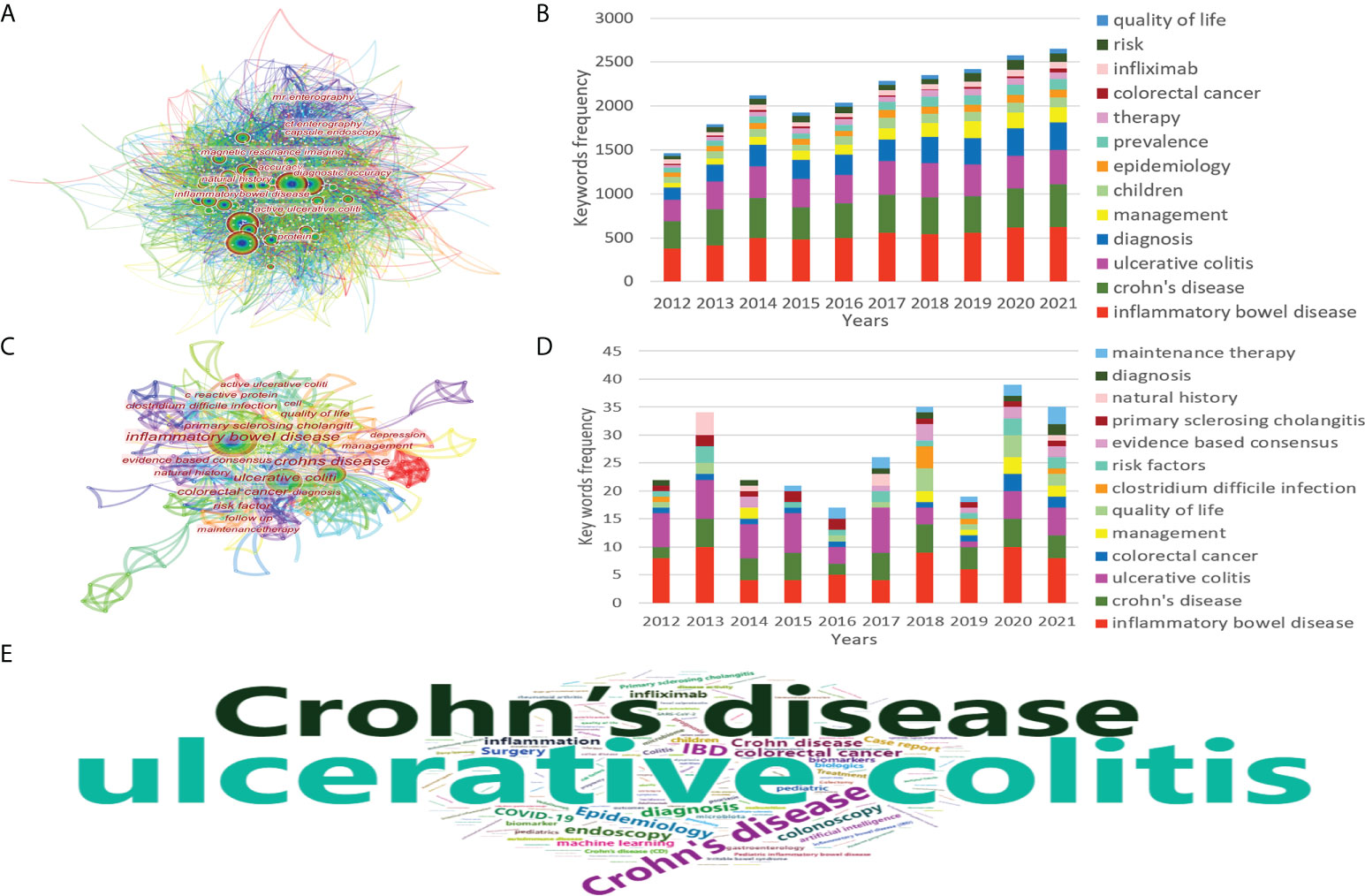
Figure 5 The co-occurrence of keywords (A), annual number of common keywords (B) of IBD diagnostic studies in the past ten years, and the co-occurrence of keywords (C), annual number of common keywords (D) of citation classics, and keywords cloud form in PubMed (E).
3.5.2 Cluster analysis
Co-word clustering was to perform correlation operations on keywords that co-occur in research articles, and cluster closely related words into categories, so as to achieve the purpose of mining hidden information. In this paper, a cluster analysis of the main keywords was performed through CiteSpace and the log-likelihood ratio (LLR) method was used to label the clusters, so as to obtain the clustering timeline view (Figures 6A, C) and time zone map (Figures 6B, D). There were two important evaluation indicators for the effect of cluster map drawing, namely Modularity Q (Q, value interval [0,1]) and Weighted Mean Silhouette S (S, value interval [-1,1]). The Q value was used to evaluate the goodness of the clustering network, and the higher the value, the better the structure of the clustering network. Q>0.3 indicated that the obtained network structure was significantly convincing. The S value was used to measure the homogeneity of cluster members, and the larger the value, the higher the consistency between members within the class. S>0.5 meant that the clustering result was reasonable. The Q values in Figure 6 were 0.3876 and 0.591 (both> 0.3), and the S values were 0.7108 and 0.8683 (both> 0.7), indicating that these clustering diagrams were reasonable and had reference value.
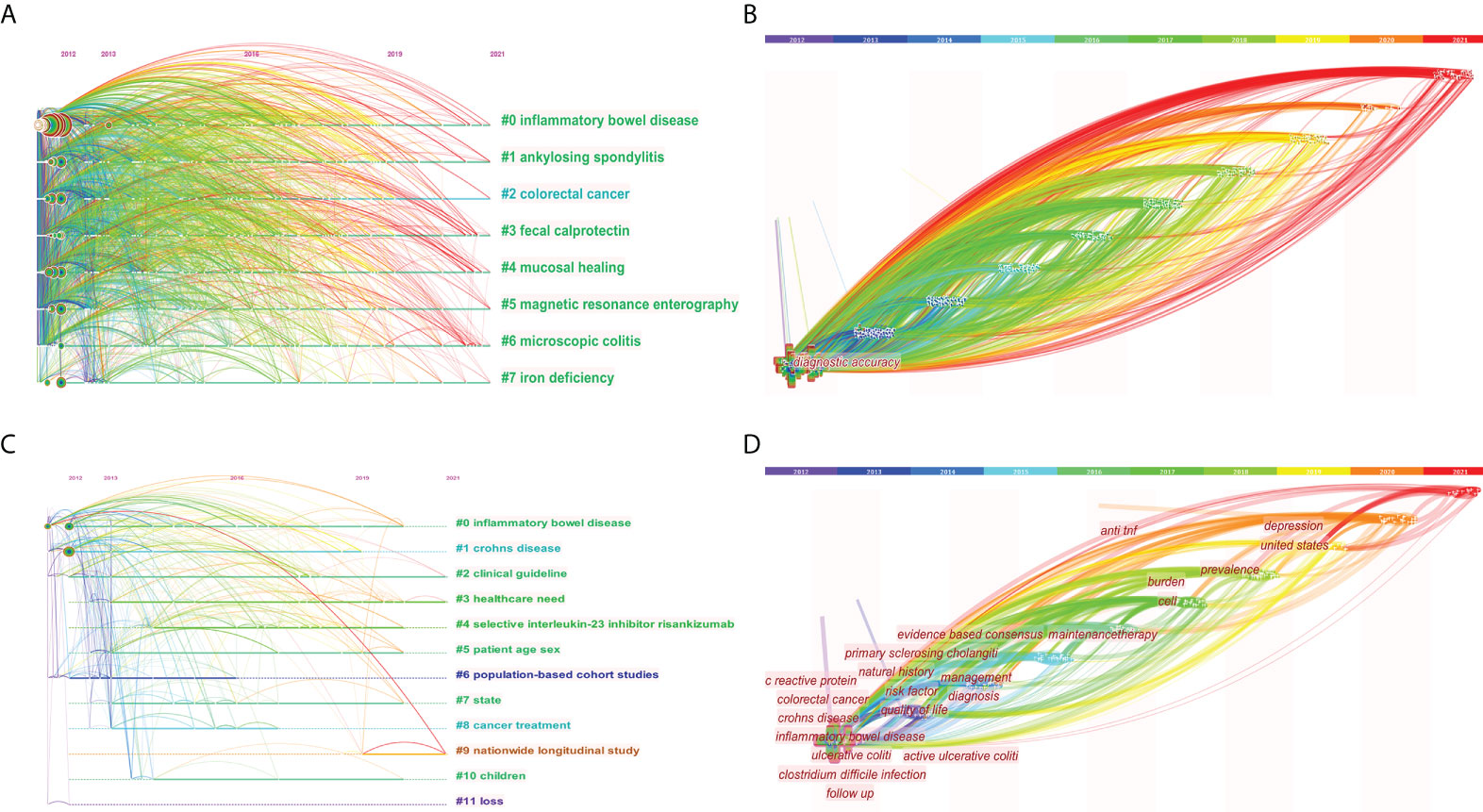
Figure 6 The clustering timeline view (A) and time zone map (B) of keywords on IBD diagnostic studies in the past ten years, and the clustering timeline view (C) and time zone map (D) of keywords of citation classics.
In the past ten years of research, 8 meaningful clusters were formed (Table 3A), and 12 clusters were formed in citation classics (Table 3B). From #0 to #12, the smaller the number, the more keywords were included in the cluster. There were multiple overlapping clusters in the keyword clustering graph, indicating that they were closely related. The clustering timeline view visually displayed the time span of each cluster and the correlation between different clusters, so as to clearly showed the evolution process of the research. The abscissa (x-axis) of the timeline view was the year of publication, and the ordinate (y-axis) was the cluster number. The keywords time zone map could clearly show the evolution process of knowledge in the time dimension, obtain the development trend of research hotspots, and provide directions for future research. The cluster analysis in this paper found that the research mainly focused on two aspects: ①research on related diseases caused or coexisting with IBD, such as colorectal cancer and autoimmune diseases; ②research on diagnosis and treatment of IBD, such as imaging diagnosis and maintenance therapy.
3.5.3 Emergent analysis
Kleinberg’s burst detection algorithm can be used to detect the sudden growth of research interest in a discipline (26). Burst detection is an original computational technique that can detect drastic changes in events. A burst of an event means the event appearance shows a surge increase, such as in the frequency of a keyword. And burst keywords may be a key direction in development trends. So, keywords emergence analysis could show that the research of a keyword had increased during a certain period of time, which meant that the attention of the keyword had increased during this period of time. The analysis of emergent words in the literature related to IBD diagnosis from 2012 to 2021 was conducted through CiteSpace software. Each emergence word had a highlight bar composed of each cell, and each cell represented a year (Table 4). In the early period of 2012-2021, IBD diagnostic research mostly lay in general characteristics and diagnostic methods. In the later period, the research hotspot of IBD diagnosis expanded to research on the treatment and mechanism of IBD, and this aspect of research needed to be further explored. It was worth noting that precision medicine might be the research trend in the future.
3.6 Literature analysis on precision diagnosis and management of IBD
Through the above analysis, we found that precision medicine might be the future research direction, and we have now entered the era of personalized medicine. Therefore, we also searched and included 96 articles related to precise diagnosis and management of IBD for analysis after inclusion and exclusion criteria.
3.6.1 General feature distribution
It was found that the related research was still mainly produced in the United States, and then China ranked second. The institution with the most articles was Katholieke Univ Leuven, with 4 articles, and the author with the most articles was CLAUDIO FIOCCHI, with 3 articles (Supplementary Table 2). The most published journal was Inflammatory Bowel Diseases, with 11 articles. Based on OALM to analyze the cooperation relationship, including the relationship between authors (Figure 7A), institutions (Figure 7B), and countries (Figure 7C), it could be seen that there were fixed cooperative relationships. At the same time, article citation relationship network analysis was also carried out (Figure 7D).
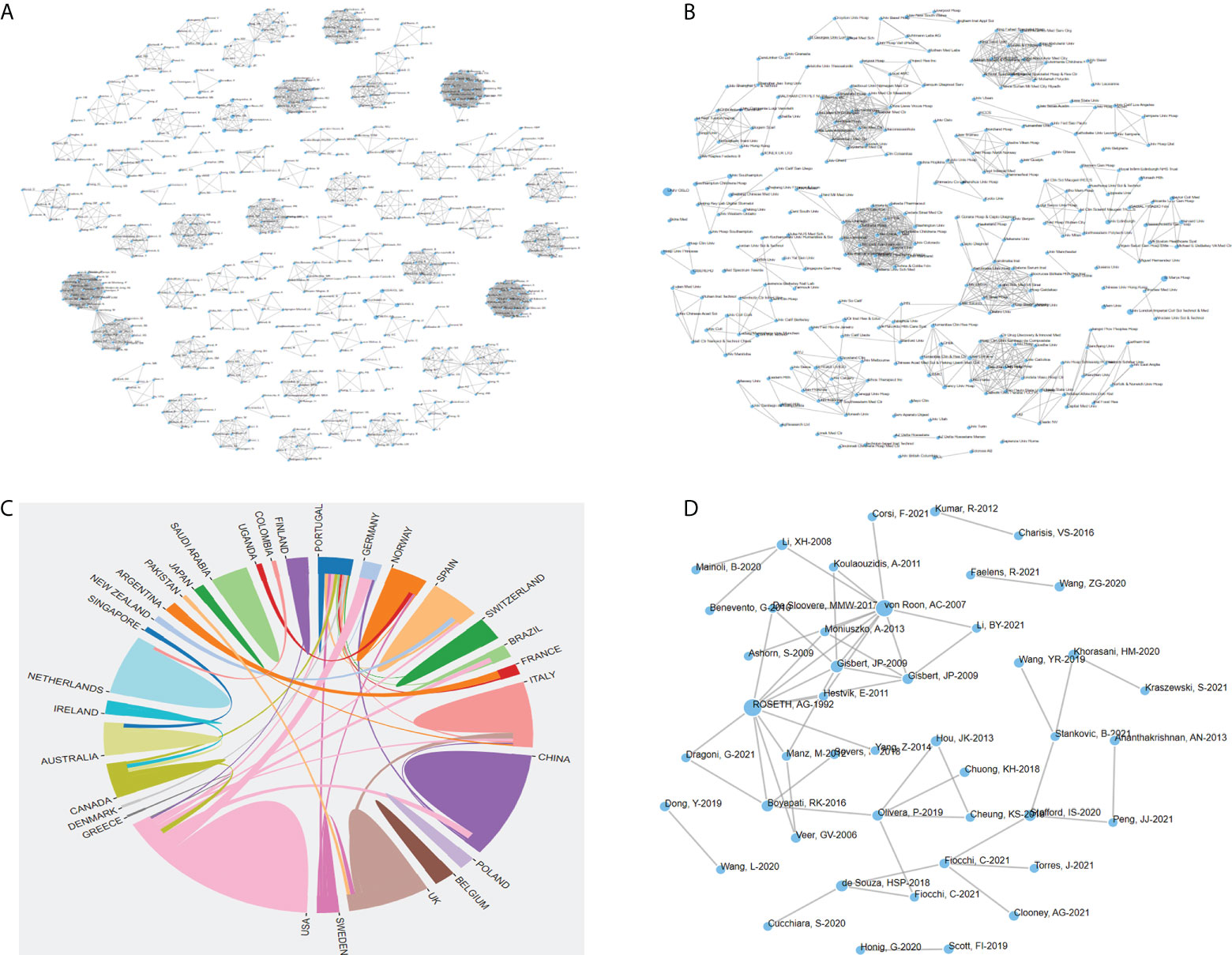
Figure 7 The cooperation relationship between authors (A), institutions (B), countries (C), and articles (D) of the literature on precision diagnosis and management of IBD.
3.6.2 Keywords analysis
335 keywords were discovered based on CiteSpace (Figure 8A). Σ (sigma) was an index of the degree of dispersion of research keywords. The higher the Σ, the stronger the correlation between the keyword and the research. We analyzed the top 12 keywords sorted by word frequency, centrality, and Σ (Table 5). The keywords were clustered analysis, and the clustering timeline view (Figure 8B) and time zone map (Figure 8C) were obtained. 13 clusters were formed (Table 3C), which were mainly concentrated on the method exploration and evaluation of precision diagnosis and management of IBD, of which 2006 was an important node. The emergence analysis showed that the future hotspots were “maintenance therapy” and “precision medicine”, especially the latter (Table 4C).
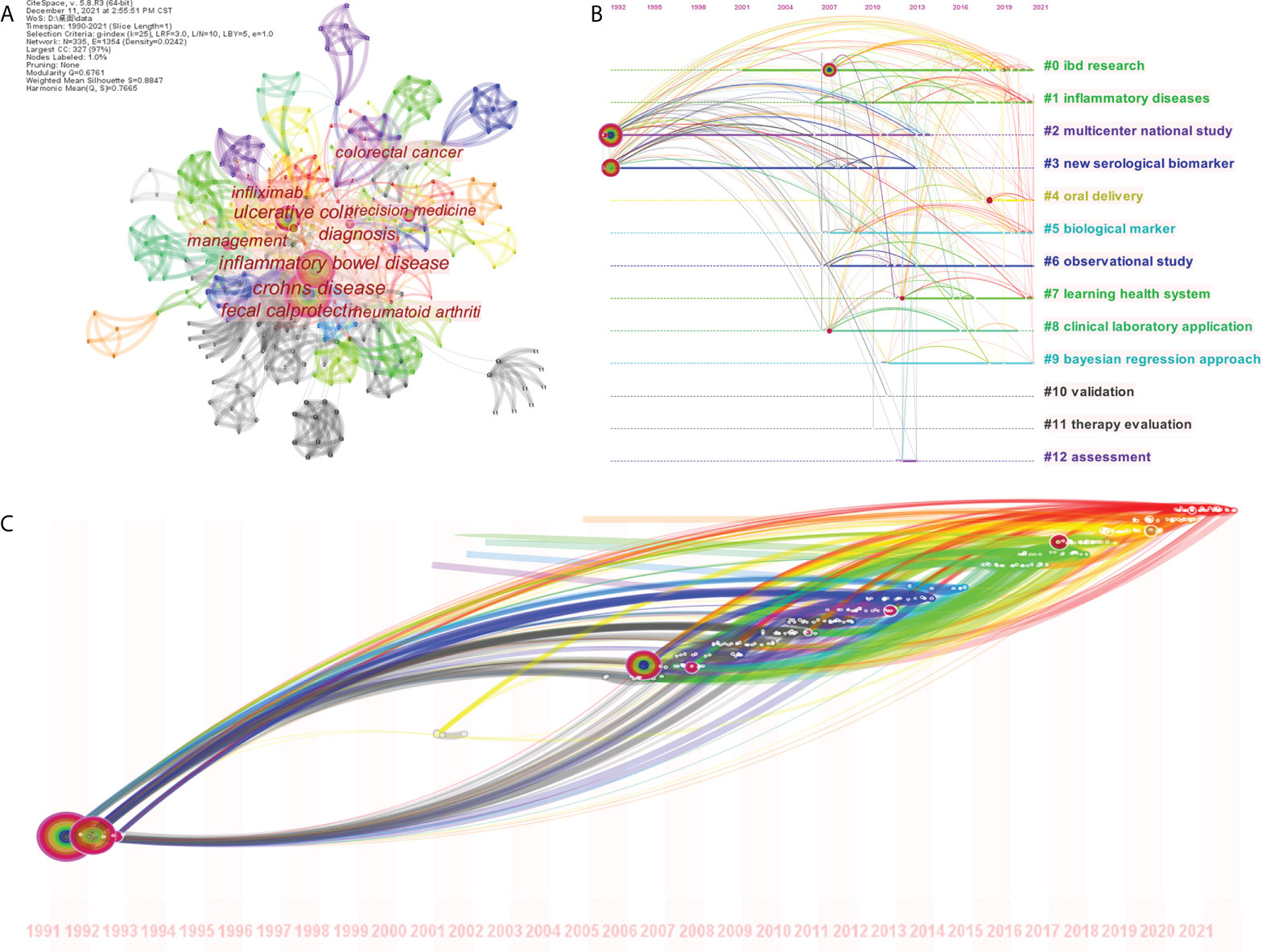
Figure 8 The co-occurrence of keywords (A), the clustering timeline view of keywords (B) and time zone map of keywords (C) of the literature on precision diagnosis and management of IBD.
4 Discussion
According to a report by Kaplan in 2015, there were more than 1 million people in the Americas and 2.5 million people in Europe with IBD (27). The lack of epidemiologic IBD data from developing countries suggested that the situation could be even worse, given an increase in incidence associated with recent industrialization (28). Early diagnosis and treatment of IBD could usually improve the quality of life of these patients, so its diagnostic research is valuable. It is particularly urgent to grasp the overview of the research field in today’s massive literature, and bibliometrics can meet this demand.
This article was the first based on the bibliometric method combined with the content analysis method to conduct a mathematical statistical analysis of the literature related to IBD diagnosis, and to mine research hotspots and development trends based on data information. Generally speaking, in order to obtain a standard CiteSpace knowledge spectrum, four processes were required: software installation, original article retrieval and download, software functional operation (including adjustment of various parameters, etc.), and graph interpretation. To collect articles accurately and comprehensively, authors should pay attention to data retrieval methods and select appropriate parameters according to their own needs, and adjust the messy spectrum to obtain a clear and beautiful spectrum.
An analysis of 14,742 articles related to IBD diagnosis included in this study from 2012 to 2021 found that the number of publications was generally on the rise, which showed that the research had prospects and potential. The number of articles published in the top 10 countries accounted for 80% of all articles, and 90% of these 10 countries were developed countries, because these countries generally had advanced medical research institutions and top medical researchers. The government had the ability to establish a complete medical security system and provided sufficient funds for drug research. Among them, the United States was far ahead and had played a leading role, which might be related to the US financial resources for scientific research (29). Canada has been the fourth largest IBD research funder in the world, investing over $119 million from 2013 to 2017. With this investment, on all measures of academic productivity and influence, Canada ranks in the top two or three internationally (30). China was the only developing country among these 10 countries, which showed that China had made great progress in this research recently. China’s investment in research and invention had surpassed that of any other country except the United States, and its funding was growing at a rate of 20% per year (31), leading to significant progress in many medical research fields (32, 33). At present, the author with the most articles on IBD diagnostic research was PEYRIN-BIROULET L from the University Hospital of Nancy-Brabois. Surprisingly, in both the analysis of total literature and citation classics, the author not only performed well in the number of publications but also in the quality of publications, which showed that he played a pivotal role in this research. Mayo Clin, Univ Toronto and Karolinska Inst were institutions with a large number of articles, and they belonged to the United States, Canada and Sweden, respectively. In addition, the United States had played a key role in promoting international cooperation, with the strongest cooperation between the United States and Canada. So, it could be found that scientists, institutions and countries all benefit from international cooperation (34). Due to the attractiveness of high IF journals to the scientific community (35), the IF of journals was in some way one of the most powerful citation indicators. Highly cited articles were usually published in high-IF journals. Researches in this field were mainly published in Inflammatory Bowel Diseases and Journal of Crohn’s colitis, with IFs of 7.29 and 10.02 respectively, which also hinted at the quality of output in this field.
Visualized analysis of keywords in the literature related to IBD diagnosis through CiteSpace revealed that the hot words were mainly “colorectal cancer”, “rheumatoid arthritis”, “clostridium difficile infection”, “primary sclerosing cholangitis”, “risk”, “therapy”, “maintenance therapy”, “quality of life”, “antibody”, “evidence-based consensus”, “diagnostic accuracy”, etc. With the continuous deepening and expansion of research, precision medicine related to “diagnostic accuracy” had become a new hot spot and trend. In the early stage of IBD diagnostic research, the general characteristics and diagnostic methods were mostly focused on. In the later stage, the research hotspot expanded to the treatment mechanism of IBD and the quality of life. The analysis of citation classics further verified the above situation.
In classifying the clustering fields, the disease fields had the highest percentages, such as infections and tumors. These diseases were mainly focused on related diseases caused by or coexisting with IBD, such as colorectal cancer and autoimmune diseases. These diseases might be related to the pathogenesis and complications of IBD. There was evidence that the diversity of the gut microbiota in IBD decreased and mucosal adherent bacteria increased (36). Changes in the intestinal microbiota led to a serious imbalance of host physiology and immune homeostasis, which ultimately led to infection and inflammation. For example, patients with IBD were particularly vulnerable to Clostridium difficile infection (CDI), with increased morbidity and mortality (37). Clostridium difficile is an intestinal pathogen, which is considered to be the main cause of antibiotic-related diarrhea and colitis, and also an important complication of IBD (38). One of the extraintestinal manifestations of IBD is primary sclerosing cholangitis (PSC), and its main clinical manifestations are related to IBD (39). Approximately 70% of patients with PSC have potential IBD, and UC is the most common in more than 75% of cases (40). PSC and IBD are interrelated diseases, mainly immune-mediated processes (41). These two diseases have common antibodies. For example, perinuclear anti-neutrophil cytoplasmic autoantibodies (p-ANCA) have been found in 26% to 85% of PSC patients and up to 68% of UC patients (42, 43). In recent years, an increasing number of studies have noted that rheumatoid arthritis (RA) tended to cluster with IBD (44, 45) and that patients with IBD are more likely to develop RA (46). In addition, anemia is one of the most common extraintestinal systemic complications of IBD, affecting approximately 41-75% of children with IBD (47). The etiology of IBD anemia is multifactorial, which may be mainly chronic inflammation and intestinal mucosal damage leading to insidious chronic blood loss (48), mainly involving iron deficiency anemia and chronic disease anemia. More importantly, increased the risk of colorectal cancer (CRC) in IBD patients has been attributed to long-standing chronic inflammation, with the contribution of genetic alterations and environmental factors such as the microbiota (49), but the detailed mechanism is still elusive (50). IBD-associated CRC (IBD-CRC) might appear through different tumorigenesis pathways, because tumors occur in the inflamed area of the colon and have characteristic clinicopathological features (51, 52).
There were also many words about IBD diagnostic methods in the keywords, such as endoscopy, C-reactive protein, fecal calprotectin, antibody, CT and so on. Endoscopic biopsy was the gold standard for determining the diagnosis of IBD. Since mucosal healing has become an important treatment goal, colonoscopy has played an important role in monitoring disease activity (53). Moreover, colonoscopy could better monitor and manage complications of colorectal tumors, such as stenosis (53). C-reactive protein was a biomarker used to monitor disease activity, but it had a poor correlation with endoscopy results, and one-third of patients never showed an increase in concentration (54). About 60-70% of patients’ serum might contain antimicrobial antibodies, the most common being the anti-Saccharomyces cerevisiae antibody (ASCA) IgA (43, 55). The sensitivity and specificity of these antibodies were too low for diagnostic purposes, such as ASCA (43), p-ANCA (43, 56), anti-ganglioside antibodies (57), etc., but these antibodies could be applied to the clinical diagnosis of other autoimmune diseases (58), such as ASCA in most patients with celiac disease (43, 59). The study showed that ASCA positivity had been found in 75% of CD patients and 27% of UC patients, and the p-ANCA was detected in 72% of UC patients and 16% of CD patients, so ASCA and p-ANCA could be used to identify UC and CD (43). Other biomarkers such as microRNA could also be used for the identification of UC and CD (60). Fecal biomarkers, including fecal calprotectin, were increasingly used as screening tests and assessing disease activity in IBD. Fecal calprotectin, a protein that could be detected in feces, whose concentration was related to the infiltration of neutrophils in the intestine, was a surrogate marker of intestinal inflammation, and could be used to monitor disease activity, evaluate treatment response, predict clinical recurrence and postoperatively relapse (61). Therefore, it had high sensitivity and specificity for the diagnosis of IBD, because patients with low fecal calprotectin had less than 1% chance of developing IBD (62). Imaging examinations such as ultrasonography, CT or MR enterography were becoming more and more important in the treatment of CD. CT or MR enterography should be performed at diagnosis to assess the extent of the disease and whether there were complications such as stenosis or fistula, thereby providing information about disease behavior (63). During follow-up, imaging was increasingly used to assess disease activity, complications, and response to treatment (64, 65). In general, imaging had a limited role in determining the diagnosis of UC. For patients with acute severe UC, toxic megacolon should be assessed by plain abdominal radiographs (64). CT and MRI might show a thickened cardia colon, but their sensitivity or specificity was not sufficient as a diagnostic tool (64). The above diagnosis methods had certain reference value, but the accuracy needed to be further explored and resolved. Therefore, it was of great significance to study the precise diagnosis and treatment mechanism of IBD in depth.
In addition, the analysis of 96 research literature on IBD precision diagnosis and management showed that in the era of individualization, precision medicine (PM) was the future direction. PM is one of the five focus areas proposed by the Crohn’s and Colitis Foundation as a “Challenge in IBD” that deserves dedicated research (66). The burden of IBD is increasing, and because it is a disease with high morbidity and high medical costs, it puts pressure on the medical system, which highlights the need for novel and effective treatment strategies for IBD. Therefore, PM has been identified as a key strategy to improve the clinical outcome of IBD (66, 67). PM aims to use the biological characteristics of individual patients to formulate the right treatment plan for the right patient at the right time (68, 69). This requires understanding the functions of individual biological components and their multi-factor interactions on the overall impact of patient stratification (70). It is expected that the multi-omics method may be more robust in guiding the precise treatment of IBD and other complex diseases (71, 72). With the exponential increase in the availability of molecular data utilized through omics technology, network biology could become a valuable tool for analyzing patient data from multiple omics to achieve the key goals of PM for IBD and other complex diseases (73, 74). In addition, artificial intelligence, including machine learning and deep learning, could provide many potential solutions for the treatment of IBD (75). However, the current research literature on PM for IBD is scarce, and its individualized precision diagnosis method and management mechanism need to be further explored to obtain the support of a large amount of basic research data.
This study has some limitations. First, this study only focuses on publications in the WoSCC database, excluding other databases, such as PubMed and Scopus, which might produce slightly different results. And although WoSCC is a comprehensive and popular online database in the field of scientometrics, it is possible that several papers on this topic have been published in journals not included in the Web of Science. Second, non-English publications are excluded, so landmark articles published in other languages are not taken into account, resulting in a small number of articles not being included. Finally, the number of citations cannot fully reflect the quality of the publication, because it takes time to cite the manuscript. Older journals may receive more citations, so influential manuscripts might take several years to generate citations.
5 Conclusions
As far as we know, this research is the first bibliometric analysis of publications in the field of IBD diagnosis using visualization software and data information mining, and has obtained the current status, hotspots, and development of this field. Research in this field mainly focuses on IBD-related diseases, and the future research hotspot might be the precision medicine of IBD, but the mechanism needs to be explored in depth to provide a theoretical basis for its clinical application. IBD researchers and practitioners can use the study results to improve their understanding of the area and can catalyze their further knowledge development. Then, it can inform novice researchers, interested readers, or research managers and evaluators without specific knowledge and help them to develop a perspective on the IBD diagnosis. Finally, the study output can serve as a guide to further research and a starting point for more formal knowledge synthesis endeavors like systematic reviews and meta-analyses.
Data availability statement
The original contributions presented in the study are included in the article/Supplementary Material. Further inquiries can be directed to the corresponding author.
Author contributions
(I) Conception and design: CL, RY, and JZ. (II) Administrative support: WD. (III) Provision of study materials or patients: CL, RY, and JZ. (IV) Collection and assembly of data: SW, FX, YG, PH, and LS. (V) Data analysis and interpretation: CL, RY, and JZ. (VI) Manuscript writing: all authors. (VII) Final approval of manuscript: all authors.
Funding
The National Natural Science Foundation of China (No. 82170549 and 82000521) and Key Science and Technology Project of Henan Science and Technology Department (No. 212102310037) funded this manuscript.
Acknowledgments
The authors would like to thank editors and the anonymous reviewers for their valuable comments and suggestions to improve the quality of the paper.
Conflict of interest
The authors declare that the research was conducted in the absence of any commercial or financial relationships that could be construed as a potential conflict of interest.
Publisher’s note
All claims expressed in this article are solely those of the authors and do not necessarily represent those of their affiliated organizations, or those of the publisher, the editors and the reviewers. Any product that may be evaluated in this article, or claim that may be made by its manufacturer, is not guaranteed or endorsed by the publisher.
Supplementary material
The Supplementary Material for this article can be found online at: https://www.frontiersin.org/articles/10.3389/fimmu.2022.972079/full#supplementary-material
References
1. Khor B, Gardet A, Xavier RJ. Genetics and pathogenesis of inflammatory bowel disease. Nature (2011) 474:307–17. doi: 10.1038/nature10209
2. Wong K, Isaac DM, Wine E. Growth delay in inflammatory bowel diseases: Significance, causes, and management. Dig Dis Sci (2021) 66:954–64. doi: 10.1007/s10620-020-06759-5
3. Ng SC, Shi HY, Hamidi N, Underwood FE, Tang W, Benchimol EI, et al. Worldwide incidence and prevalence of inflammatory bowel disease in the 21st century: A systematic review of population-based studies. Lancet (2017) 390:2769–78. doi: 10.1016/S0140-6736(17)32448-0
4. Ungaro R, Mehandru S, Allen PB, Peyrin-Biroulet L, Colombel JF. Ulcerative colitis. Lancet (2017) 389:1756–70. doi: 10.1016/S0140-6736(16)32126-2
5. Torres J, Mehandru S, Colombel JF, Peyrin-Biroulet L. Crohn's disease. Lancet (2017) 389:1741–55. doi: 10.1016/S0140-6736(16)31711-1
6. Nikolaus S, Schreiber S. Diagnostics of inflammatory bowel disease. Gastroenterology (2007) 133:1670–89. doi: 10.1053/j.gastro.2007.09.001
7. Greuter T, Vavricka SR. Extraintestinal manifestations in inflammatory bowel disease - epidemiology, genetics, and pathogenesis. Expert Rev Gastroenterol Hepatol (2019) 13:307–17. doi: 10.1080/17474124.2019.1574569
8. Johnston RD, Logan RF. How often is ibd diagnosed incidentally at screening colonoscopy done for colorectal cancer surveillance or other reasons? Inflammation Bowel Dis (2008) 14 Suppl 2:S170–1. doi: 10.1002/ibd.20596
9. Peyrin-Biroulet L, Bressenot A, Kampman W. Histologic remission: The ultimate therapeutic goal in ulcerative colitis? Clin Gastroenterol Hepatol (2014) 12:929–34. doi: 10.1016/j.cgh.2013.07.022
10. Inflammatory Bowel Disease Group, Chinese Society of Gastroenterology, Chinese Medical Association. Chinese Consensus on diagnosis and treatment in inflammatory bowel disease (2018, beijing). J Dig Dis (2021) 22:298–317. doi: 10.1111/1751-2980.12994
11. Maaser C, Sturm A, Vavricka SR, Kucharzik T, Fiorino G, Annese V, et al. Ecco-esgar guideline for diagnostic assessment in ibd part 1: Initial diagnosis, monitoring of known ibd, detection of complications. J Crohns Colitis (2019) 13:144–64. doi: 10.1093/ecco-jcc/jjy113
12. Wang B, Pan S, Ke R, Wang K, Wei Y. An overview of climate change vulnerability: A bibliometric analysis based on web of science database. Nat Hazards (2014) 74:1649–66. doi: 10.1007/s11069-014-1260-y
13. Shiffrin RM, Borner K. Mapping knowledge domains. Proc Natl Acad Sci USA (2004) 101 Suppl 1:5183–5. doi: 10.1073/pnas.0307852100
14. Zheng M, Fu HZ, Ho YS. Research trends and hotspots related to ammonia oxidation based on bibliometric analysis. Environ Sci Pollut Res Int (2017) 24:20409–21. doi: 10.1007/s11356-017-9711-0
15. Yang J, Cheng C, Song C, Shen S, Ning L. Visual analysis of the evolution and focus in landslide research field. J Mt Sci-Engl (2019) 16:991–1004. doi: 10.1007/s11629-018-5280-z
16. Chen CM. Citespace ii: detecting and visualizing emerging trends and transient patterns in scientific literature. J Of Am Soc For Inf Sci And Technol (2006) 57:359–77. doi: 10.1002/asi.20317
17. Liang C, Luo A, Zhong Z. Knowledge mapping of medication literacy study: a visualized analysis using citespace. SAGE Open Med (2018) 6:2105872199. doi: 10.1177/2050312118800199
18. Dehghanbanadaki H, Aazami H, Keshavarz ARS, Ashrafian F, Ejtahed HS, Hashemi E, et al. Global scientific output trend for akkermansia muciniphila research: A bibliometric and scientometric analysis. BMC Med Inform Decis Mak (2020) 20:291. doi: 10.1186/s12911-020-01312-w
19. Liu P, Zhang C, Lu Z, Feng J, Xu W, Yang Z. Global research status and trends of uka for knee osteoarthritis: A bibliometric analysis. Arthroplasty (2020) 2:20. doi: 10.1186/s42836-020-00039-3
20. Ma H, Li H, Liu P, Liu P, Zhang X, Zhang Y, et al. Bibliometric analysis of china’s contribution to the knowledge system of cerebrovascular intervention. Chin Neurosurgical J (2021) 7:50. doi: 10.1186/s41016-021-00264-y
21. Connelly TM, Devane L, Kelly JC, Wrafter P, Messaris E. The 100 classic papers in ulcerative colitis: A bibliometric analysis. Expert Rev Gastroenterol Hepatol (2016) 10:1187–95. doi: 10.1080/17474124.2016.1216786
22. Schoffel N, Bendels MH, Groneberg DA. Ulcerative colitis: A scientometric approach to the global research output and network. Eur J Intern Med (2016) 34:e41–3. doi: 10.1016/j.ejim.2016.06.019
23. Azer SA, Azer S. What can we learn from top-cited articles in inflammatory bowel disease? A bibliometric analysis and assessment of the level of evidence. BMJ Open (2018) 8:e21233. doi: 10.1136/bmjopen-2017-021233
24. Molodecky NA, Soon IS, Rabi DM, Ghali WA, Ferris M, Chernoff G, et al. Increasing incidence and prevalence of the inflammatory bowel diseases with time, based on systematic review. Gastroenterology (2012) 142:46–54. doi: 10.1053/j.gastro.2011.10.001
25. Sun J, Wang MH, Ho YS. A historical review and bibliometric analysis of research on estuary pollution. Mar Pollut Bull (2012) 64:13–21. doi: 10.1016/j.marpolbul.2011.10.034
26. Kleinberg J. Bursty and hierarchical structure in streams. Data Min Knowl Disc (2003) 7:373–97. doi: 10.1023/A:1024940629314
27. Kaplan GG. The global burden of ibd: from 2015 to 2025. Nat Rev Gastroenterol Hepatol (2015) 12:720–7. doi: 10.1038/nrgastro.2015.150
28. Kaplan GG, Ng SC. Understanding and preventing the global increase of inflammatory bowel disease. Gastroenterology (2017) 152:313–21. doi: 10.1053/j.gastro.2016.10.020
29. Zhao SX, Yu S, Tan AM, Xu X, Yu H. Global pattern of science funding in economics. Scientometrics (2016) 109:463–79. doi: 10.1007/s11192-016-1961-y
30. Rose KL, Sherman PM, Cooke-Lauder J, Mawani M, Benchimol EI, Kaplan GG, et al. The impact of inflammatory bowel disease in Canada 2018: ibd research landscape in canada. J Can Assoc Gastroenterol (2019) 2:S81–91. doi: 10.1093/jcag/gwy057
32. Xing D, Zhao Y, Dong S, Lin J. Global research trends in stem cells for osteoarthritis: A bibliometric and visualized study. Int J Rheum Dis (2018) 21:1372–84. doi: 10.1111/1756-185X.13327
33. Ye J, Ding H, Ren J, Xia Z. The publication trend of neuropathic pain in the world and china: A 20-years bibliometric analysis. J Headache Pain (2018) 19:110. doi: 10.1186/s10194-018-0941-4
34. Adams J. Collaborations: The fourth age of research. Nature (2013) 497:557–60. doi: 10.1038/497557a
35. Garfield E. The history and meaning of the journal impact factor. JAMA (2006) 295:90–3. doi: 10.1001/jama.295.1.90
36. Nagalingam NA, Lynch SV. Role of the microbiota in inflammatory bowel diseases. Inflammation Bowel Dis (2012) 18:968–84. doi: 10.1002/ibd.21866
37. D'Aoust J, Battat R, Bessissow T. Management of inflammatory bowel disease with clostridium difficile infection. World J Gastroenterol (2017) 23:4986–5003. doi: 10.3748/wjg.v23.i27.4986
38. Razik R, Rumman A, Bahreini Z, McGeer A, Nguyen GC. Recurrence of clostridium difficile infection in patients with inflammatory bowel disease: The recidivism study. Am J Gastroenterol (2016) 111:1141–6. doi: 10.1038/ajg.2016.187
39. Weismuller TJ, Trivedi PJ, Bergquist A, Imam M, Lenzen H, Ponsioen CY, et al. Patient age, sex, and inflammatory bowel disease phenotype associate with course of primary sclerosing cholangitis. Gastroenterology (2017) 152:1975–84. doi: 10.1053/j.gastro.2017.02.038
40. de Vries AB, Janse M, Blokzijl H, Weersma RK. Distinctive inflammatory bowel disease phenotype in primary sclerosing cholangitis. World J Gastroenterol (2015) 21:1956–71. doi: 10.3748/wjg.v21.i6.1956
41. Palmela C, Peerani F, Castaneda D, Torres J, Itzkowitz SH. Inflammatory bowel disease and primary sclerosing cholangitis: A review of the phenotype and associated specific features. Gut Liver (2018) 12:17–29. doi: 10.5009/gnl16510
42. Rossi RE, Conte D, Massironi S. Primary sclerosing cholangitis associated with inflammatory bowel disease: An update. Eur J Gastroenterol Hepatol (2016) 28:123–31. doi: 10.1097/MEG.0000000000000532
43. Granito A, Zauli D, Muratori P, Muratori L, Grassi A, Bortolotti R, et al. Anti-saccharomyces cerevisiae and perinuclear anti-neutrophil cytoplasmic antibodies in coeliac disease before and after gluten-free diet. Aliment Pharmacol Ther (2005) 21:881–7. doi: 10.1111/j.1365-2036.2005.02417.x
44. Bae JM, Choo JY, Kim KJ, Park KS. Association of inflammatory bowel disease with ankylosing spondylitis and rheumatoid arthritis: A nationwide population-based study. Mod Rheumatol (2017) 27:435–40. doi: 10.1080/14397595.2016.1211229
45. Chen Y, Chen L, Xing C, Deng G, Zeng F, Xie T, et al. The risk of rheumatoid arthritis among patients with inflammatory bowel disease: A systematic review and meta-analysis. BMC Gastroenterol (2020) 20:192. doi: 10.1186/s12876-020-01339-3
46. Park SW, Kim TJ, Lee JY, Kim ER, Hong SN, Chang DK, et al. Comorbid immune-mediated diseases in inflammatory bowel disease: A nation-wide population-based study. Aliment Pharmacol Ther (2019) 49:165–72. doi: 10.1111/apt.15076
47. Wiskin AE, Fleming BJ, Wootton SA, Beattie RM. Anaemia and iron deficiency in children with inflammatory bowel disease. J Crohns Colitis (2012) 6:687–91. doi: 10.1016/j.crohns.2011.12.001
48. Resal T, Farkas K, Molnar T. Iron deficiency anemia in inflammatory bowel disease: What do we know? Front Med (Lausanne) (2021) 8:686778. doi: 10.3389/fmed.2021.686778
49. Lucafo M, Curci D, Franzin M, Decorti G, Stocco G. Inflammatory bowel disease and risk of colorectal cancer: An overview from pathophysiology to pharmacological prevention. Front Pharmacol (2021) 12:772101. doi: 10.3389/fphar.2021.772101
50. Ullman TA, Itzkowitz SH. Intestinal inflammation and cancer. Gastroenterology. (2011) 140:1807–16. doi: 10.1053/j.gastro.2011.01.057
51. Rajamaki K, Taira A, Katainen R, Valimaki N, Kuosmanen A, Plaketti RM, et al. Genetic and epigenetic characteristics of inflammatory bowel disease-associated colorectal cancer. Gastroenterology (2021) 161:592–607. doi: 10.1053/j.gastro.2021.04.042
52. Lu C, Schardey J, Zhang T, Crispin A, Wirth U, Karcz KW, et al. Survival outcomes and clinicopathological features in inflammatory bowel disease-associated colorectal cancer: A systematic review and meta-analysis. Ann Surg (2021). doi: 10.1097/SLA.0000000000005339
53. Annese V, Daperno M, Rutter MD, Amiot A, Bossuyt P, East J, et al. European Evidence based consensus for endoscopy in inflammatory bowel disease. J Crohns Colitis (2013) 7:982–1018. doi: 10.1016/j.crohns.2013.09.016
54. Mosli MH, Zou G, Garg SK, Feagan SG, MacDonald JK, Chande N, et al. C-reactive protein, fecal calprotectin, and stool lactoferrin for detection of endoscopic activity in symptomatic inflammatory bowel disease patients: A systematic review and meta-analysis. Am J Gastroenterol (2015) 110:802–19, 820. doi: 10.1038/ajg.2015.120
55. Vermeire S, Peeters M, Vlietinck R, Joossens S, Den Hond E, Bulteel V, et al. Anti-saccharomyces cerevisiae antibodies (asca), phenotypes of ibd, and intestinal permeability: A study in ibd families. Inflammation Bowel Dis (2001) 7:8–15. doi: 10.1097/00054725-200102000-00002
56. Reese GE, Constantinides VA, Simillis C, Darzi AW, Orchard TR, Fazio VW, et al. Diagnostic precision of anti-saccharomyces cerevisiae antibodies and perinuclear antineutrophil cytoplasmic antibodies in inflammatory bowel disease. Am J Gastroenterol (2006) 101:2410–22. doi: 10.1111/j.1572-0241.2006.00840.x
57. Granito A, Tovoli F, Raiteri A, Volta U. Anti-ganglioside antibodies and celiac disease. Allergy Asthma Clin Immunol (2021) 17:53. doi: 10.1186/s13223-021-00557-y
58. Granito A, Muratori P, Tovoli F, Muratori L. Anti-neutrophil cytoplasm antibodies (anca) in autoimmune diseases: A matter of laboratory technique and clinical setting. Autoimmun Rev (2021) 20:102787. doi: 10.1016/j.autrev.2021.102787
59. Granito A, Muratori L, Muratori P, Guidi M, Lenzi M, Bianchi FB, et al. Anti-saccharomyces cerevisiae antibodies (asca) in coeliac disease. Gut (2006) 55:296.
60. Yarani R, Shojaeian A, Palasca O, Doncheva NT, Jensen LJ, Gorodkin J, et al. Differentially expressed mirnas in ulcerative colitis and crohn's disease. Front Immunol (2022) 13:865777. doi: 10.3389/fimmu.2022.865777
61. Menees SB, Powell C, Kurlander J, Goel A, Chey WD. A meta-analysis of the utility of c-reactive protein, erythrocyte sedimentation rate, fecal calprotectin, and fecal lactoferrin to exclude inflammatory bowel disease in adults with ibs. Am J Gastroenterol (2015) 110:444–54. doi: 10.1038/ajg.2015.6
62. Sands BE. Biomarkers of inflammation in inflammatory bowel disease. Gastroenterology (2015) 149:1275–85. doi: 10.1053/j.gastro.2015.07.003
63. Ordas I, Rimola J, Rodriguez S, Paredes JM, Martinez-Perez MJ, Blanc E, et al. Accuracy of magnetic resonance enterography in assessing response to therapy and mucosal healing in patients with crohn's disease. Gastroenterology (2014) 146:374–82. doi: 10.1053/j.gastro.2013.10.055
64. Panes J, Bouhnik Y, Reinisch W, Stoker J, Taylor SA, Baumgart DC, et al. Imaging techniques for assessment of inflammatory bowel disease: Joint ecco and esgar evidence-based consensus guidelines. J Crohns Colitis (2013) 7:556–85. doi: 10.1016/j.crohns.2013.02.020
65. Pariente B, Mary JY, Danese S, Chowers Y, De Cruz P, D'Haens G, et al. Development of the lemann index to assess digestive tract damage in patients with crohn's disease. Gastroenterology (2015) 148:52–63. doi: 10.1053/j.gastro.2014.09.015
66. Denson LA, Curran M, McGovern D, Koltun WA, Duerr RH, Kim SC, et al. Challenges in ibd research: Precision medicine. Inflammation Bowel Dis (2019) 25:S31–9. doi: 10.1093/ibd/izz078
67. Torres J, Halfvarson J, Rodriguez-Lago I, Hedin C, Jess T, Dubinsky M, et al. Results of the seventh scientific workshop of ecco: Precision medicine in ibd-prediction and prevention of inflammatory bowel disease. J Crohns Colitis (2021) 15:1443–54. doi: 10.1093/ecco-jcc/jjab048
68. Whitcomb DC. Primer on precision medicine for complex chronic disorders. Clin Transl Gastroenterol (2019) 10:e67. doi: 10.14309/ctg.0000000000000067
69. Torres J. Prediction of inflammatory bowel disease: A step closer? Gastroenterology (2020) 158:278–9. doi: 10.1053/j.gastro.2019.11.006
70. Sudhakar P, Machiels K, Verstockt B, Korcsmaros T, Vermeire S. Computational biology and machine learning approaches to understand mechanistic microbiome-host interactions. Front Microbiol (2021) 12:618856. doi: 10.3389/fmicb.2021.618856
71. Olivera P, Danese S, Jay N, Natoli G, Peyrin-Biroulet L. Big data in ibd: a look into the future. Nat Rev Gastroenterol Hepatol (2019) 16:312–21. doi: 10.1038/s41575-019-0102-5
72. Borg-Bartolo SP, Boyapati RK, Satsangi J, Kalla R. Precision medicine in inflammatory bowel disease: Concept, progress and challenges. F1000Res (2020) 9:54. doi: 10.12688/f1000research.20928.1
73. Thomas JP, Modos D, Korcsmaros T, Brooks-Warburton J. Network biology approaches to achieve precision medicine in inflammatory bowel disease. Front Genet (2021) 12:760501. doi: 10.3389/fgene.2021.760501
74. Korcsmaros T, Schneider MV, Superti-Furga G. Next generation of network medicine: Interdisciplinary signaling approaches. Integr Biol (Camb) (2017) 9:97–108. doi: 10.1039/c6ib00215c
Keywords: inflammatory bowel disease, diagnosis, precision medicine, bibliometric, keywords, CiteSpace
Citation: Liu C, Yu R, Zhang J, Wei S, Xue F, Guo Y, He P, Shang L and Dong W (2022) Research hotspot and trend analysis in the diagnosis of inflammatory bowel disease: A machine learning bibliometric analysis from 2012 to 2021. Front. Immunol. 13:972079. doi: 10.3389/fimmu.2022.972079
Received: 17 June 2022; Accepted: 26 August 2022;
Published: 14 September 2022.
Edited by:
Alessandro Granito, University of Bologna, ItalyReviewed by:
Linda Beenet, University of California, Los Angeles, United StatesPan Song, Sichuan University, China
Copyright © 2022 Liu, Yu, Zhang, Wei, Xue, Guo, He, Shang and Dong. This is an open-access article distributed under the terms of the Creative Commons Attribution License (CC BY). The use, distribution or reproduction in other forums is permitted, provided the original author(s) and the copyright owner(s) are credited and that the original publication in this journal is cited, in accordance with accepted academic practice. No use, distribution or reproduction is permitted which does not comply with these terms.
*Correspondence: Weiguo Dong, ZG9uZ3dlaWd1b0B3aHUuZWR1LmNu
†These authors have contributed equally to this work
 Chuan Liu1†
Chuan Liu1† Weiguo Dong
Weiguo Dong